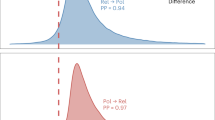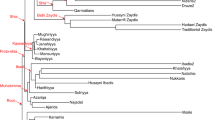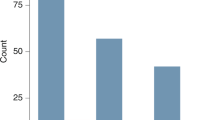Abstract
Evidence for human sacrifice is found throughout the archaeological record of early civilizations1, the ethnographic records of indigenous world cultures2,3,4,5, and the texts of the most prolific contemporary religions6. According to the social control hypothesis2,7,8, human sacrifice legitimizes political authority and social class systems, functioning to stabilize such social stratification. Support for the social control hypothesis is largely limited to historical anecdotes of human sacrifice2,8, where the causal claims have not been subject to rigorous quantitative cross-cultural tests. Here we test the social control hypothesis by applying Bayesian phylogenetic methods to a geographically and socially diverse sample of 93 traditional Austronesian cultures. We find strong support for models in which human sacrifice stabilizes social stratification once stratification has arisen, and promotes a shift to strictly inherited class systems. Whilst evolutionary theories of religion have focused on the functionality of prosocial and moral beliefs9,10, our results reveal a darker link between religion and the evolution of modern hierarchical societies11,12.
This is a preview of subscription content, access via your institution
Access options
Subscribe to this journal
Receive 51 print issues and online access
$199.00 per year
only $3.90 per issue
Buy this article
- Purchase on Springer Link
- Instant access to full article PDF
Prices may be subject to local taxes which are calculated during checkout


Similar content being viewed by others
References
Bremmer, J. N. The Strange World of Human Sacrifice (Peeters, 2007)
Carrasco, D. City of Sacrifice (Beacon Press, 1999)
Beatty, A. Society and Exchange in Nias (Claredon Press, 1992)
Burt, B. Tradition and Christianity: the Colonial Transformation of a Solomon Islands Society (Harwood Academic Publishers, 1994)
Del Castillo, B. D. The History of the Conquest of New Spain . (Univ. New Mexico Press, 2008)
Johnson, T. M. & Grimm B. J. The World’s Religions in Figures: an Introduction to International Religious Demography (Wiley, 2013)
Winkelman, M. Political and demograpic-ecological determinants of institutionalised human sacrifice. Anthropol. Forum 24, 47–70 (2014)
Turner, C. G. & Turner, J. A. Man Corn: Cannibalism and Violence in the Prehistroic American Southwest (Univ. Utah Press, 1999)
Norenzayan, A. et al. The cultural evolution of prosocial religions. Behav. Brain Sci. 39, http://dx.doi.org/10.1017/S0140525X14001356 (2014)
Watts, J. et al. Broad supernatural punishment but not moralising high gods precede the evolution of political complexity in Austronesia. Proc. R. Soc. B 282, http://dx.doi.org/10.1098/rspb.2014.2556 (2015)
Cronk, L. Evolutionary theories of morality and the manipulative use of signals. Zygon 29, 81–101 (1994)
Marx, K. & Engels, F. Karl Marx and Friedrich Engels: Collected Works (International Publishers, 1975)
Girard, R., Hamerton-Kelly, R. G., Burkert, W. & Smith, J. Z. Violent Origins: Walter Burkert, René Girard & Jonathan Z. Smith on Ritual Killing and Cultural Formation (Stanford Univ. Press, 1987)
Burkert, W. Creation of the Sacred: Tracks of Biology in Early Religions (Harvard Univ. Press, 1998)
Price, B. J. Demystification, enriddlement, and Aztec cannibalism: a materialist rejoinder to Harner. Am. Ethnol. 5, 98–115 (1978)
Harner, M. The ecological basis for Aztec sacrifice. Am. Ethnol. 4, 117–135 (1977)
Gould, S. J. & Lewontin, R. C. The spandrels of San Marco and the Panglossian paradigm: a critique of the adaptationist programme. Proc. R. Soc. Lond. B 205, 581–598 (1979)
Wilson, E. O. On Human Nature (Harvard Univ. Press, 1978)
Coulanges, F. The Ancient City: a study of Religion, Laws, and Institutions of Greece and Rome (Lee and Shepard, 1877)
Flannery, K. & Marcus, J. The Creation of Inequality: How Our Prehistroic Ancestors Set The Stage for Monarchy, Slavery, and Empire (Harvard Univ. Press, 2012)
Wheatley, P. The Pivot of the Four Quarters (Edinburgh Univ. Press, 1971)
Dow, M. & Eff, E. Global, regional, and local network autocorrelation in the standard cross-cultural sample. Cross-Cultural Res . 42, 148–171 (2008)
Pagel, M. & Meade, A. Bayesian analysis of correlated evolution of discrete characters by reversible-jump Markov chain Monte Carlo. Am. Nat. 167, 808–825 (2006)
Watts, J. et al. Pulotu: database of Austronesian supernatural beliefs and practices. PLoS ONE 10, e0136783 (2015)
Gray, R. D., Drummond, A. J. & Greenhill, S. J. Language phylogenies reveal expansion pulses and pauses in Pacific settlement. Science 323, 479–483 (2009)
Goodenough, W. Oceania and the problem of controls in the study of cultural and human evolution. J. Polyn. Soc. 66, 146–155 (1957)
Kamakau, S. M. Ka Po’E Kahiko: the People of Old (Bernice P. Bishop Museum Press, 1968)
Ronay, R., Greenaway, K., Anicich, E. M. & Galinsky, A. D. The path to glory is paved with hierarchy: when hierarchical differentiation increases group effectiveness. Psychol. Sci. 23, 669–677 (2012)
Lammers, J., Galinsky, A. D., Gordijin, E. H. & Sabine, O. Illegitimacy moderates the effect of power on approach. Psychol. Sci. 19, 558–564 (2008)
Bellah, R. N. Religion in Human Evolution: From the Paleolithic to the Axial Age (Harvard Univ. Press, 2011)
Sahlins, M. D. Social Stratification in Polynesia . (Univ. Washington Press, 1958)
Ko, A. M. et al. Early Austronesians: into and out of Taiwan. Am. J. Hum. Genet. 94, 426–436 (2014)
Team, R. Core. R: A Language and Environment for Statistical Computing . (R Found. Stat. Comput. 2015)
Orme, D. et al. Caper: Comparative Analyses of Phylogenetics and Evolution in R. R package version 0.5.2. http://cran.r-project.org/package=caper (2013)
Fritz, S. A. & Purvis, A. Selectivity in mammalian extinction risk and threat types: a new measure of phylogenetic signal strength in binary traits. Conserv. Biol. 24, 1042–1051 (2010)
Mace, R. & Pagel, M. The comparative method in anthropology. Curr. Anthropol. 35, 549–564 (1994)
Mace, R. & Holden, C. J. A phylogenetic approach to cultural evolution. Trends Ecol. Evol. 20, 116–121 (2005)
Xie, W., Lewis, P. O., Fan, Y., Kuo, L. & Chen, M.-H. Improving marginal likelihood estimation for Bayesian phylogenetic model selection. Syst. Biol. 60, 150–160 (2011)
Raftery, A. E. in Markov Chain Monte Carlo in Practice 163–188 (Chapman & Hall, 1996)
Maddison, W. P. & FitzJohn, R. G. The unsolved challange of phylogenetic correlation tests for categorical characters. Syst. Biol. 64, 127–136 (2015)
Drummond, A. J., Suchard, M. A., Xie, D. & Rambaut, A. Bayesian Phylogenetics with BEAUti and the BEAST 1.7. Mol. Biol. Evol. 29, 1969–1973 (2012)
Paradis, E., Claude, J. & Strimmer & K. APE: analyses of phylogenetics and evolution in R language. Bioinformatics 20, 289–290 (2004)
Acknowledgements
We would like to thank K. Sterelny for feedback on an earlier version of the manuscript as well as M. Pagel and A. Meade for assistance with BayesTraits. We would also like to thank The John Templeton Foundation (28745), Templeton World Charity Foundation (0077), a Rutherford Discovery Fellowship (RDF-OUA1101), a PhD scholarship from the University of Auckland, and the Marsden Fund (UOA1104, VUW1321) for funding.
Author information
Authors and Affiliations
Contributions
J.W. designed the study with Q.D.A., J.B. and R.D.G. J.W. and O.S. jointly created and coded the variables. J.W. performed the analyses with input from Q.D.A and R.D.G. J.W., O.S., Q.D.A., J.B. and R.D.G. reviewed the results and wrote the paper.
Corresponding author
Ethics declarations
Competing interests
The authors declare no competing financial interests.
Extended data figures and tables
Extended Data Figure 1 Phylogenetic distribution of human sacrifice and social stratification in Austronesia.
Ancestral state reconstruction of human sacrifice and general social stratification on a maximum clade credibility consensus tree of 93 Austronesian languages. This analysis was run for 2 × 109 iterations and replicated three times. Pie charts at the nodes represent the probable ancestral state inferred in an unconstrained dependent reversible-jump Markov chain Monte Carlo23 analysis. Grey represents the proportion of our sample of 4,200 trees in which that node is absent.
Supplementary information
Supplementary Information
This file contains Supplementary Tables 1-26. Please note that Supplementary Table 1 documents the sources used to code each culture with links to additional references and Supplementary Tables 2-26 provide additional results from our phylogenetic analyses. (PDF 2385 kb)
PowerPoint slides
Rights and permissions
About this article
Cite this article
Watts, J., Sheehan, O., Atkinson, Q. et al. Ritual human sacrifice promoted and sustained the evolution of stratified societies. Nature 532, 228–231 (2016). https://doi.org/10.1038/nature17159
Received:
Accepted:
Published:
Issue Date:
DOI: https://doi.org/10.1038/nature17159
This article is cited by
-
Supernatural explanations across 114 societies are more common for natural than social phenomena
Nature Human Behaviour (2023)
-
Coevolution of religious and political authority in Austronesian societies
Nature Human Behaviour (2022)
-
A phylogenetic analysis of revolution and afterlife beliefs
Nature Human Behaviour (2021)
-
The Scapegoat Mechanism in Human Evolution: An Analysis of René Girard’s Hypothesis on the Process of Hominization
Biological Theory (2021)
-
What Do We Talk About When We Talk About Culture? There is a Missing Link Between the Natural and the Social Sciences
Integrative Psychological and Behavioral Science (2021)
Comments
By submitting a comment you agree to abide by our Terms and Community Guidelines. If you find something abusive or that does not comply with our terms or guidelines please flag it as inappropriate.



